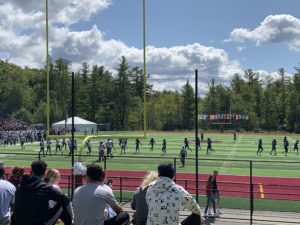Explainer: College students’ concussions
by Bailey Matteson
Franklin Pierce has had four student athletes suffer from a concussion since the beginning of this academic year.
Concussions occur when the body or head is jolted causing the brain to make contact with the skull and inducing bruising and minor bleeding.
Jesse L’heureux, athletic trainer for Franklin Pierce, stands on the side line at football games observing the impact athlete each takes. If L’heureux has a concern of a possible concussion they are taken out of the game and observed by interning athletic trainers that run a concussions test while L’heureux returns to watching the game for other injuries.
According to the CDC 1.6 to 3.8 million sports and recreation-related Traumatic Brain Injuries occur each year in the United States. College athletes suffered an average of 10,500 concussions in the past five years, with 3,400 occurring in football according to NCAA.

According to a New York Times article just the normal contact of football has an effect on the brain. A study conducted by Bradford Mahon documented “what happens inside the skulls of football players whose heads repeatedly collide with the ground and each other but who have not had concussions” said New York Times. The results showed that football players that took the most hits to the head had a greater disruption inside their midbrains white matter.
College campuses with NCAA sports are required to have a concussion protocol. L’heureux said, “Every concussion is different. One person can have two concussions and they can have totally different symptoms.”
The return to play protocol also applies to returning to academics. Andrew Pollom, Dean of Student Affairs, said, “I or my office will reach out to the student’s professor saying they may need extra time on
their assignments, but it is at the discretion of the students whether they want to disclose they have a concussion. Nine times out of ten they do.”
If the concussion symptoms are bad enough accommodations can be made through the Center for Academic Excellence. Pollom said, “A concussion is day by day, I’ve had student who dealt with concussion all four-year I’ve known them. In other cases, I’ve had students who were confused for a couple of days and by the end of the week they are good to go.”
Since there is a high risk of concussions in student athletes the NCAA started a research fund in 2014 to learn more about concussions.

